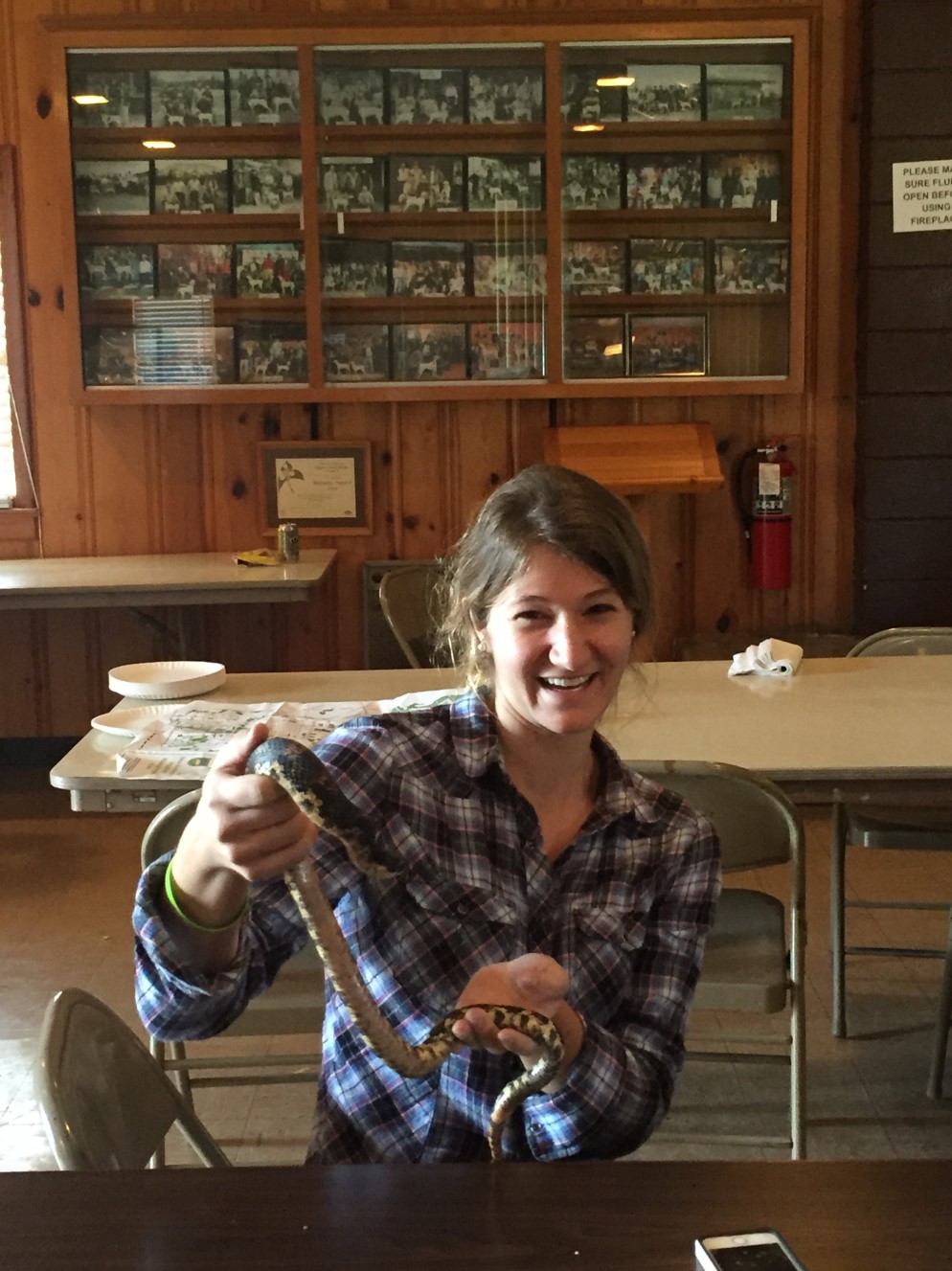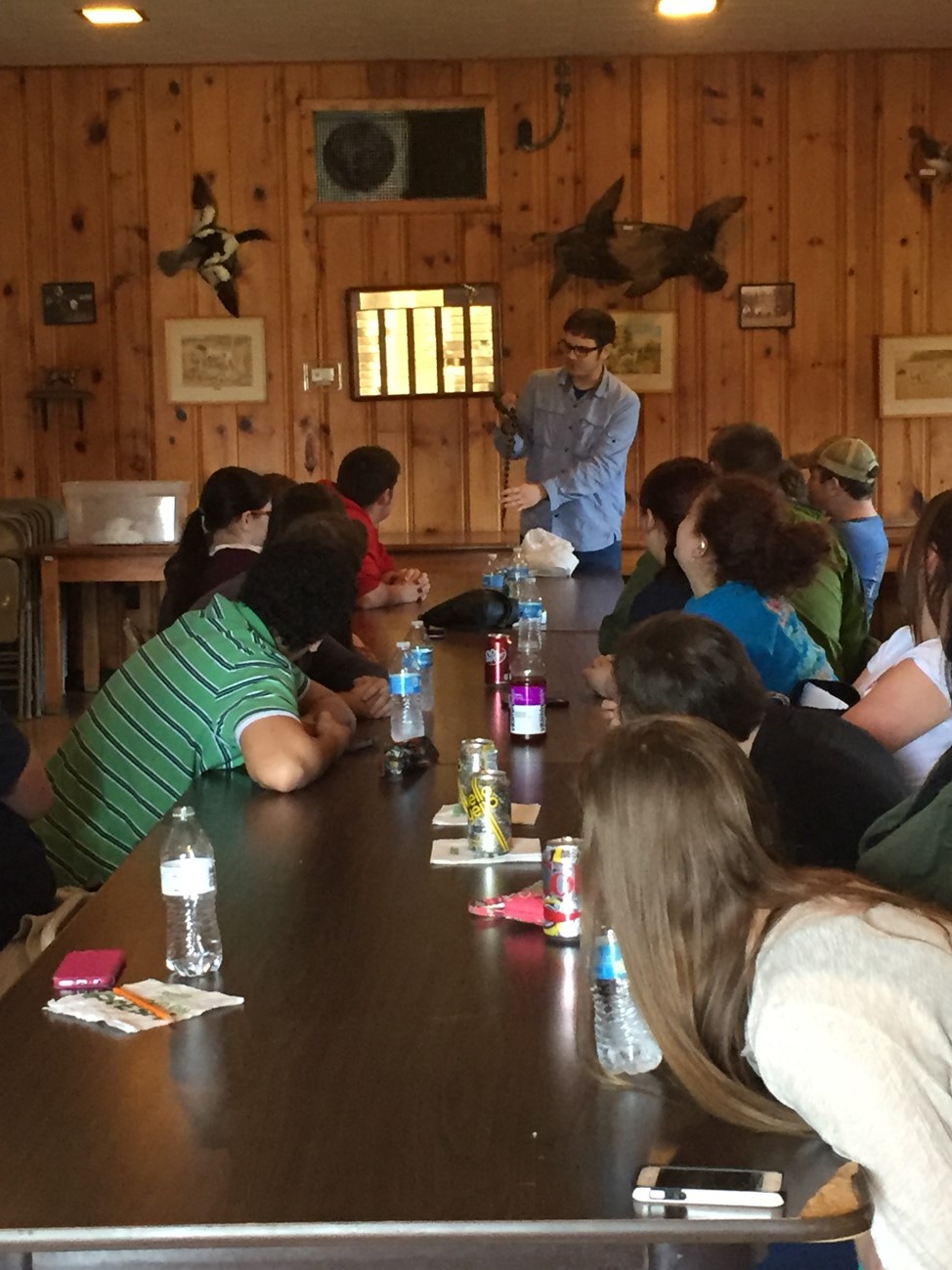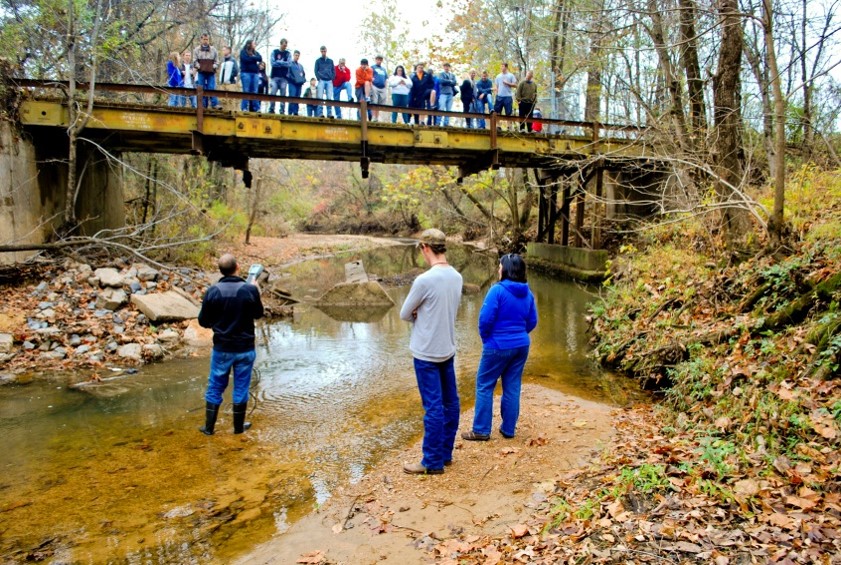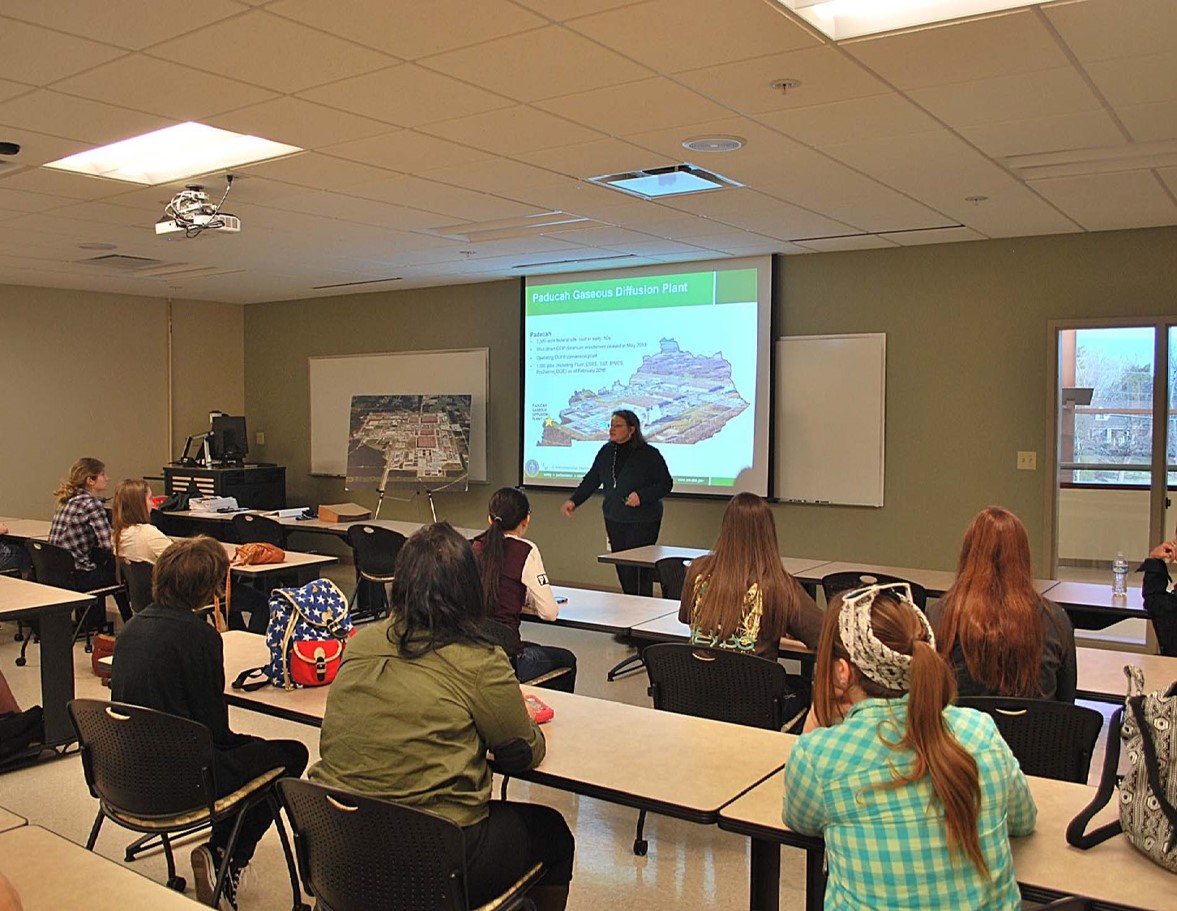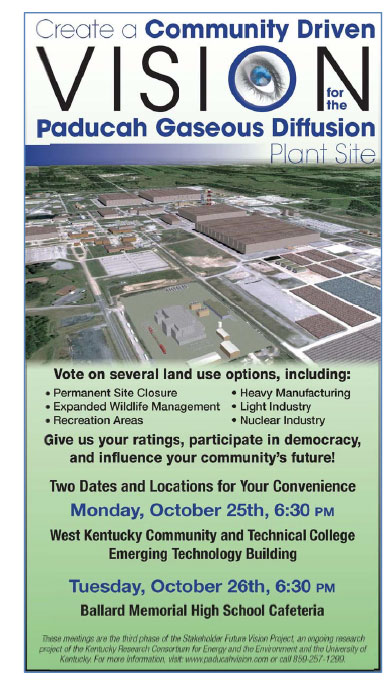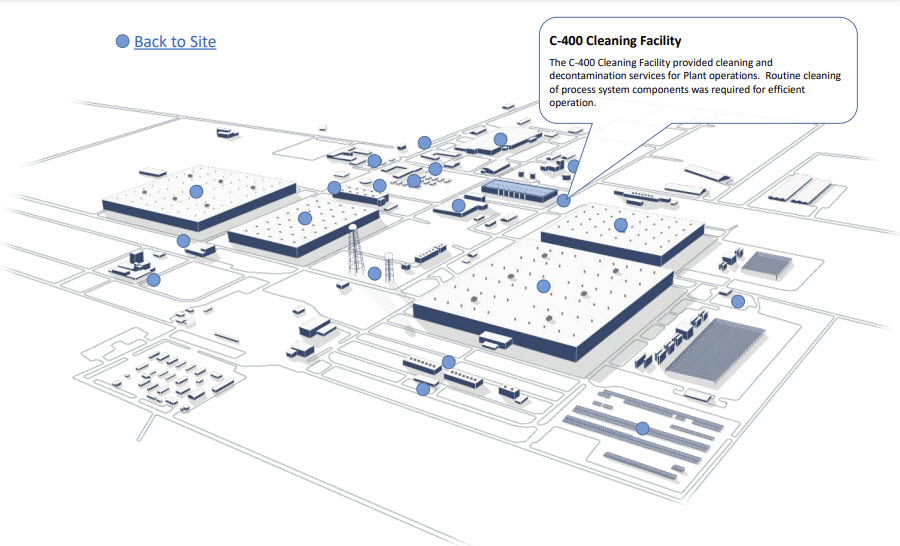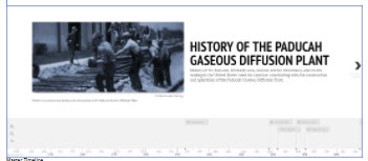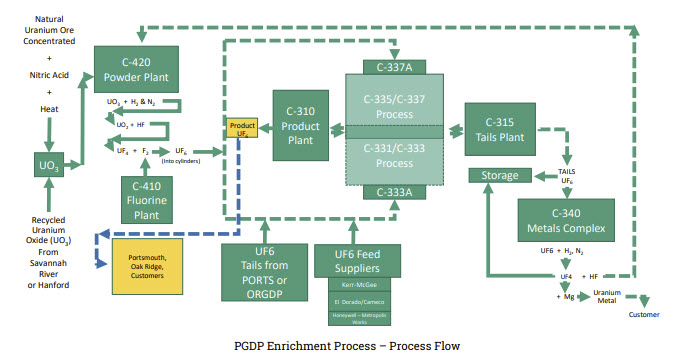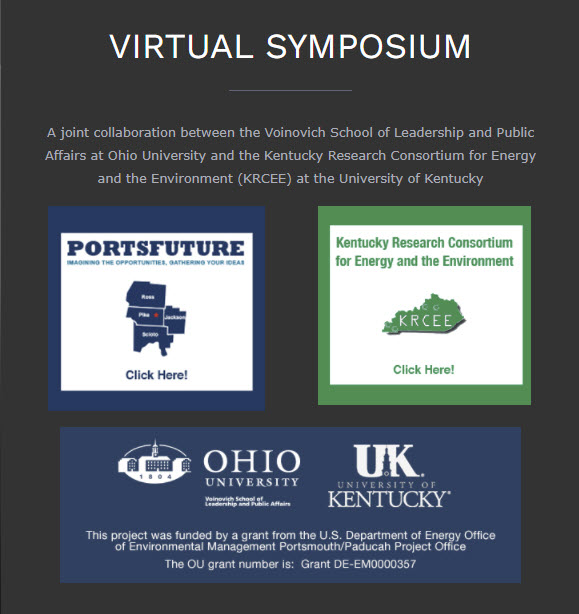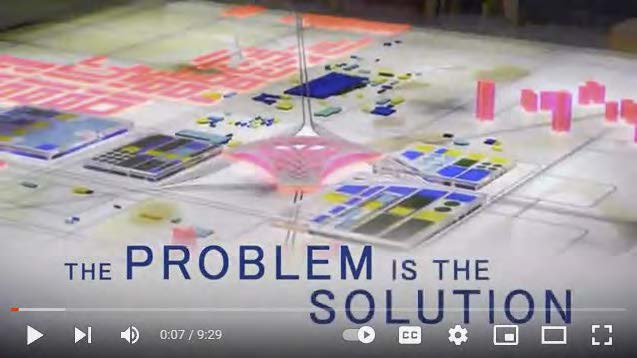Public Outreach:
Education, History
& Future Use
BACKGROUND
The Paducah Gaseous Diffusion Plant operated under the shroud of Cold War secrecy from the early 1950s through the late 1980s. Plant operators and workers functioned under the provisions of security clearances that prohibited discussion of the PGDP’s mission of enriching uranium for Cold War weapons and nuclear power generation. Several generations of residents and workers grew up only quietly acknowledging the PGDP’s presence. Outside of the Jackson Purchase Region and Paducah, little was known about the existence, no less the importance, of the PGDP’s missions.
Generations worldwide were taught to “duck and cover”, fallout shelters were constructed in backyards, and silent fear was instilled with the mention of the words “nuclear”, “radiation” & “atomic”. Public awareness and media coverage of gross industrial age environmental impacts and resulting health threats grew exponentially during the late 1960s and continued into the 1970s & 1980s. The Environmental Protection Agency started in the 1970s and with it, the cleanup of the Industrial Age’s legacies.
In the 1980s the “veil of secrecy” was lifted and information about the government & DOE’s Cold War industrial and science efforts entered the public conversation. Stories of clandestine secret projects occurring on the government’s nuclear sites remained more common in the public forum than data disclosing the nature and extent of Cold War facilities environmental and health impacts. Data to identify environmental and health impacts was slowly being collected, assessed and selectively released. Environmental activism proliferated, allegations of the government’s mishandling of materials with disregard for health & safety found its way into the court of public opinion, lawsuits, and regulations.
Fast forward to the late 1990s – 2000s, a new era of digital information and a new era of public awareness and participation in government activities. Public discussion about the retirement, dismantling, and cleanup of government facilities evolved to include future use: futures of communities, economies, employment, environmental impacts & cleanups. The onset of public participation in government and government projects had occurred along with acute challenges to inform, interact with and educate government officials, stakeholders and the local community.
Since 2003, KRCEE public outreach and education projects have evolved in response to the needs of local citizens, government and public officials, and the DOE. Initial public outreach activities focused on informing community representatives, management, regulators, and site contractors with focused technical information regarding contemporary and alternative approaches to addressing cleanup and re-use problems. Technical meeting presentations have evolved into public interaction projects that gather and assess community perceptions and needs along with providing information and tools that foster understanding and the ability to address the challenges faced in the cleanup and re-use of the PGDP.
ANNUAL SITE ENVIRONMENTAL REPORT (ASER) PROJECT
Each Department of Energy (DOE) site prepares an Annual Site Environmental Report (ASER) documenting its environmental activities during a calendar year. The PGDP ASER document is a technical document relating the Site’s environmental activities and data to an extensive list of regulatory requirements.
KRCEE personnel, PGDP personnel, UK and industry subject matter experts (SMEs) assist Marshall County High School (MCHS) environmental science students with a STEM (science, technology, engineering & math) program focused on the preparation of an annual ‘PGDP ASER: High School Summary Report’.
The PGDP ASER: High School Summary Report provides streamlined information on “what the public should know” about PGDP’s environmental activities. Students review the most recent published copy of the PGDP ASER, answer study questions and summarize content prior to publication and widespread distribution.
In addition to production of the ASER High School Summary Report, students are provided introductory PGDP presentations from the DOE site office and tour the PGDP site industrial facilities and environmental projects.
The students utilize the PGDP Virtual Museum to conduct research on PGDP’s history. Subject matter experts provide several classroom presentations that range from the recent history of the PGDP to radioactive materials and ecosystem primers.
Students participate in ‘hands on’ fieldwork assessing habitats and biota that occupy the DOE reservation and West Kentucky Wildlife Management Area (WKWMA) which surrounds the PGDP site.
The ASER project is an ongoing project that began in 2013 with 17 MCHS environmental science students. In 2021, 130+ students were participating in the ASER Project through their enrollment in MCHS environmental science classes.
Project Team
Tessa Pinkerton, Multimedia Specialist, CAER
Dr. Steve Price, Professor, Forestry and Natural Resources, University of Kentucky
Andrea Drayer, Forestry and Natural Resources, University of Kentucky
Jill Newman, Forestry and Natural Resources, University of Kentucky
Tim Kreher, Manager, West Kentucky Wildlife Management Area
Tina Marshall, Environmental Science Instructor, Marshall County High School
Dr. Richard S. Halbrook, Associate Professor (Emeritus), Zoology, Southern Illinois University Carbondale
Stephanie Brock, Manager, Radiation and Environmental Monitoring Laboratory, Kentucky Cabinet for Health Services
Robert “Buz” Smith, Paducah Site Office, U.S. Department of Energy
Jennifer Woodard, PGDP Site Manager, U.S. Department of Energy
Tracey Duncan, Paducah Site Office, U.S. Department of Energy
Dr. Richard Bonczek, Portsmouth-Paducah Project Office, U.S. Department of Energy
Tracy Taylor, Engineer, ETAS, Paducah Site Contractor
Dr. Martin Clauberg, ETAS, Paducah Site Contractor
Eddie Spraggs, Paducah Site Contractor
Steve Christmas, Four Rivers Nuclear Partnership
Dr. Darrell Taulbee, CAER
Jean Hartinger, CAER
Steve Hampson, Associate Director, KRCEE
Project Documents
PGDP FUTURE VISION PROJECT
Subject matter experts from the Kentucky Water Resources Research Institute (KWRRI), the Kentucky Transportation Center (KTC), College of Engineering, College of Communications, and KRCEE assisted the local community in their efforts to identify a future use vision for the PGDP.
The PGDP Future Vision Project (a.k.a. Public End State Project) was an extensive public outreach and community involvement project. The project was conducted to engage public participation in order to identify community preferences for the future use of the PGDP industrial site and DOE reservation.
The project integrated several applied public engagement theoretical approaches in order to garner the public’s participation. Lessons learned from past DOE public participation projects which are published in the DOE document ‘The Politics of Cleanup’ were also integrated into the project methodology.
The project involved educating the public about site history, economic impacts, the history and status of ongoing environmental activities. An extensive project website, paducahvision.org, was deployed to support community participants as they explored PGDP’s past and potential future activities.
An extensive list of stakeholder representatives participated in early phases of project work in order to identify 12 possible future use scenarios. The future use scenarios were presented to community participants for discussion and identification of preferred future use(s).
Public preferences regarding the future of the PGDP are discussed in the project final report ‘Community Visions for the Paducah Gaseous Diffusion Plant Site’ and project documents below.
Public and stakeholder participation for this project far exceeded all previous DOE and UK site-related projects involving public participation.
Future PGDP Use Scenarios Evaluated for PGDP Future Vision Project
| Public End State Scenario | Scenario Description | Scenario Page Link (Map & Video) |
| Scenario 1 | Scenario 1 Description: Nuclear plant on Plant site; Wildlife Management Area (WMA) remains; all Plant decommissioning waste kept onsite in Waste Disposal Alternative (WDA); existing burial grounds excavated and moved to managed landfills | http://paducahvision.org/scenario-1.html |
| Scenario 2 | Scenario 2 Description: Nuclear plant on Plant site; WMA remains; part of Plant decommissioning waste kept onsite in WDA; existing burial grounds sealed and left in place | http://paducahvision.org/scenario-2.html |
| Scenario 3 | Scenario 3 Description: Heavy industry on Plant site; recreational facilities added to WMA; all Plant decommissioning waste removed from site; existing burial grounds excavated and moved to managed landfills | http://paducahvision.org/scenario-3.html |
| Scenario 4 | Scenario 4 Description: Heavy industry on Plant site; WMA remains; all Plant decommissioning waste kept onsite in WDA; existing burial grounds sealed and left in place | http://paducahvision.org/scenario-4.html |
| Scenario 5 | Scenario 5 Description: Light industry on Plant site; recreational facilities added to WMA; some Plant decommissioning waste kept onsite in WDA; existing burial grounds excavated and moved to managed landfills | http://paducahvision.org/scenario-5.html |
| Scenario 6 | Scenario 6 Description: Light industry on Plant site; WMA remains; all Plant decommissioning waste removed from site; existing burial grounds sealed and left in place | http://paducahvision.org/scenario-6.html |
| Scenario 7 | Scenario 7 Description: Recreational facilities on Plant site; WMA remains; some Plant decommissioning waste kept onsite in WDA; existing burial grounds sealed and left in place | http://paducahvision.org/scenario-7.html |
| Scenario 8 | Scenario 8 Description: Recreational racilities on Plant site; recreational facilities added to WMA; all Plant decommissioning waste kept onsite in WDA; existing burial grounds excavated and moved to managed landfills | http://paducahvision.org/scenario-8.html |
| Scenario 9 | Scenario 9 Description: Nature preserve on Plant site; recreational facilities added to WMA; all Plant decommissioning waste removed from site; existing burial grounds sealed and left in place | http://paducahvision.org/scenario-9.html |
| Scenario 10 | Scenario 10 Description: Nature preserve on Plant site; WMA remains; some Plant decommissioning waste kept onsite in WDA; existing burial grounds excavated and moved to managed landfills | http://paducahvision.org/scenario-10.html |
| Scenario 11 | Scenario 11 Description: Plant site sealed, fenced, access restricted; WMA remains; all Plant decommissioning waste removed from site; existing burial grounds excavated and moved to managed landfills | http://paducahvision.org/scenario-11.html |
| Scenario 12 | Scenario 12 Description: Plant site sealed, fenced, access restricted; recreational facilities added to WMA; all Plant decommissioning waste kept onsite in WDA; existing burial grounds sealed and left in place | http://paducahvision.org/scenario-12.html |
Project Team
Dr. Lindell Ormsbee, Director, KWRRI, and Professor, Civil Engineering, University of Kentucky (PI)
Dr. Chike Anyaegbunam, Professor, Integrated Strategic Communications, University of Kentucky
Dr. Ted Grossardt, Kentucky Transportation Center
Dr. Keiron Bailey, University of Arizona
John Ripey, Kentucky Transportation Center
Ben Blandford, Kentucky Transportation Center
Dr. Anna Hoover, KWRRI
Mitchael Schwartz, College of Communications, University of Kentucky
Dr. Richard Bonczek, Portsmouth-Paducah Project Office, U.S. Department of Energy
Steve Hampson, Associate Director, KRCEE
Project Documents
PROPERTY ACQUISITION (LAND STUDY) STUDY REPORT
The PGDP Property Acquisition Study (Land Study) was conducted in accordance with a Congressional Directive to DOE in the Energy and Water Development Appropriation Bill, 2006 (Senate Report 109-084).
“Within the funds provided the Department shall undertake a study of the potential purchase of property or options to purchase property that is located above the plume of contaminated groundwater near the facility site. The study shall evaluate the adequate protection of human health and environment from exposure to contaminated groundwater and consider whether such purchase, when considering the cost of remediation, long-term surveillance, and maintenance, is in the best interest of taxpayers.”
The Land Study required a groundwater modeling evaluation for a complete range of groundwater remedial alternatives identified in PGDP decision (regulatory program) documents. Five alternatives were identified, No Action and four potential Response Action scenarios (Table 3.4.1). For each alternative, the temporal as well as maximum extent of plume impacts was modeled over a 100-year period.
A KWRRI & UK-Civil Engineering Project Team applied experience in site groundwater modeling (see Groundwater Modeling) to conduct MODFLOW and MODFLOWT simulations of each remedial action scenario using the 1998-99 PGDP Flow and Transport Models (Bechtel-Jacobs, DOE, 1998*).
Faculty and staff from KRCEE, the University of Kentucky College of Law, College of Agriculture, Department of Biosystems and Agriculture Engineering, and College of Engineering provided their relevant expertise for subject matter in the report, and its use in report evaluations:
- Legal framework for applicable property acquisition and access options
- Rural residential and agricultural property valuation
- Groundwater modeling to identify temporal and spatial contaminant extents relative to application of a variety of potential remedial actions
- GIS
- Marketing and public relations
Costs to purchase potentially impacted properties and costs to implement the five (5) possible remedial action assemblages are discussed in the Property Acquisition Study Final Report.
*DOE (U.S. Department of Energy) 1998. Ground Water Flow Model Recalibration and Transport Model Construction at the PGDP, Paducah, Kentucky, DOE/OR/07-1742&DO, United States Department of Energy, Paducah, KY, June 1998.
Project Team
Dr. Lindell Ormsbee, Director, KWRRI, and Professor, Civil Engineering, University of Kentucky (co-PI)
Dr. Srinivasa Lingireddy, Associate Professor, Civil Engineering, University of Kentucky (co-PI)
Dr. Chandramouli Viswanathan, KWRRI (co-PI)
James Kipp, Associate Director, KWRRI
Teri Dowdy, Biosystems and Agricultural Engineering, University of Kentucky
Steve Hampson, Associate Director, KRCEE
Project Documents
PGDP HISTORY PROJECT
The PGDP History Project was initiated to create documentary resources (print, video and online) detailing the history of the site. The Project encompassed several components including a history book, a web-based video oral history focused on the experiences of plant employees, and a PGDP history documentary.
The Project Team’s initial activity was the development of a draft 220-page history documentary storyboard which was submitted to the PGDP Citizens Advisory Board (CAB) for review. Following the review and discussions with the DOE Portsmouth Paducah Project Office, the CAB compiled and published a PGDP pictorial history book, “Megatons to Megawatts“.
Project Team:
Dr. Lindell Ormsbee, Director, KWRRI, and Professor, Department of Civil Engineering, University of Kentucky (PI)
John Robertson, Historian, Paducah, Kentucky
Fiona Young-Brown, Writer/Author/Editor
Carol Butler, Editor, Butler Books
History Committee, Paducah Gaseous Diffusion Plant Citizens Advisory Board
Project Documents
HISTORY PROJECT: PGDP VIDEO ORAL HISTORY
West Kentucky Community and Technical College (WKCTC) Paducah Visual Communication and Multimedia Program arranged and videotaped interviews with former PGDP workers, local citizens, and community leaders to document “The Story of the Paducah Gaseous Diffusion Plant”.
Project Participants
Dr. Lindell Ormsbee, Director, KWRRI, and Professor, Department of Civil Engineering, University of Kentucky (Co-PI)
Andrew Evitts, Instructor, WKCTC (Co-PI & Director)
Christopher Bower, WKCTC (Narrator)
Chris Gilbert, WKCTC (Editor)
Dan Tanner, WKCTC (Editor)
Grace Baldridge, Student, WKCTC (Interviewer)
Robby Ballard, Student, WKCTC (Interviewer)
Randall Barnes, Student, WKCTC (Interviewer)
Moki Blanding, Student, WKCTC (Interviewer)
Josh Brown, Student, WKCTC (Interviewer)
Meghan Doyle, Student, WKCTC (Interviewer)
Mitchell Dunaway, Student, WKCTC (Interviewer)
Kristen Johnson, Student, WKCTC (Interviewer)
McKenzy Mangrum, Student, WKCTC (Interviewer)
Kayce Prescott, Student, WKCTC (Interviewer)
Beverly Quimby, Student, WKCTC (Interviewer)
JR Roper, Student, WKCTC (Interviewer)
Crys Terrell, Student, WKCTC (Interviewer)
Lauren Barclay, Student, WKCTC (Camera/Audio/Lighting)
Andrew Cummins, Student, WKCTC (Camera/Audio/Lighting)
Drew Johnson, Student, WKCTC (Camera/Audio/Lighting)
Vanessa Kaiser, Student, WKCTC (Camera/Audio/Lighting)
Jared Parish, Student, WKCTC (Camera/Audio/Lighting)
Donald Shaw, Student, WKCTC (Camera/Audio/Lighting)
Alan Simpson, Student, WKCTC (Camera/Audio/Lighting)
Dan Tanner, Student, WKCTC (Camera/Audio/Lighting)
Wil Woods, Student, WKCTC (Camera/Audio/Lighting)
Project Documents
HISTORY PROJECT: HISTORY OF THE PADUCAH GASEOUS DIFFUSION PLANT
The Kentucky Water Resources Research Institute (KWRRI), West Kentucky Community and Technical College (WKCTC) Visual Communication and Multimedia Program and the PGDP Citizens Advisory Board developed the video documentary “The History of the Paducah Gaseous Diffusion Plant”.
Project Team:
Dr. Lindell Ormsbee, Director, KWRRI, and Professor, Department of Civil Engineering, University of Kentucky (PI)
John Robertson, Historian, Paducah, Kentucky
Fiona Young-Brown, Writer/Author/Editor
Carol Butler, Editor, Butler Books
History Committee, Paducah Gaseous Diffusion Plant Citizens Advisory Board,
Project Documents
UK CoD ATOMIC CITY STUDIOS
SUSTAINABLE DEVELOPMENT & PGDP PHYSICAL MODEL DEVELOPMENT
The PGDP Virtual Museum Project began with a team of graduate and upperclassman College of Design (CoD) students researching the PGDP, recording available information about the site’s history, operations and impacts. The team compiled that information as an interactive digital “museum”. The CoD Project Team presented the “beta Virtual Museum” to DOE-PPPO managers in August 2016.
Project Team:
Anne Filson, Professor, College of Design, University of Kentucky (Co-PI)
Gary Rohrbacher, Associate Professor, College of Design, University of Kentucky (Co-PI)
Brad Mitzefeldt, Public Relations, DOE-PPPO Contractor
Dr. Bobette Nourse, DOE-PPPO Support Contractor, Knoxville, Tennessee
Chris Westfall, Graduate Student, College of Design, University of Kentucky
Steven Schwab, Graduate Student, College of Design, University of Kentucky
Sydney Kidd, Graduate Research Assistant, College of Design, University of Kentucky
Steve Hampson, Associate Director, KRCEE
DEVELOPMENT OF THE PGDP VIRTUAL MUSEUM
The PGDP Virtual Museum (VM) is an ongoing project that involves development of an interactive website detailing the history of the PGDP from “The Need for Uranium” through site construction, enrichment operations, site missions, and remediation of environmental impacts.
In late 2016 KRCEE organized a PGDP VM Project Team comprised of DOE, DOE contractors, PPPO contractors, UK-CoD PIs, UK-CoD graduate students. The PGDP VM Project Team was tasked to augment information on the beta Virtual Museum website with information released from the PGDP “vault” and “hands on” information from a retired PGDP site historian.
The PGDP VM Project Team supplemented the Beta VM content with several additional museum displays including a page highlighting Site “missions” and an expanded timeline that focused on four timeline themes: 1) History of Paducah and the Jackson Purchase; 2) History of Nuclear Science Leading to Nuclear Energy; 3) PGDP Site History; and 4) History of Environmental Regulations and PGDP Environmental Accomplishments.
The VM Project Team submitted and posted a Draft Final Virtual Museum in 2018. The PGDP Virtual Museum was released in September 2021 following completion of a formal DOE security review.
Project Team:
Anne Filson, Professor, College of Design, University of Kentucky (Co-PI)
Gary Rohrbacher, Associate Professor, College of Design, University of Kentucky (Co-PI)
Brad Mitzefeldt, Public Relations, DOE-PPPO Contractor
Tracey Taylor, Engineer, DOE-PPPO Contractor
Eddie Spraggs, Public Relations, DOE-PPPO Contractor
Dr. Bobette Nourse, DOE-PPPO Support Contractor, Knoxville, Tennessee
Tessa Pinkerton, Multimedia Specialist/Webmaster, CAER, University of Kentucky
Steve Hampson, Associate Director, KRCEE
Project Documents
VIRTUAL SYMPOSIUM
KRCEE and Ohio University collaborated to deploy a website featuring video summaries of their respective projects at the Paducah Gaseous Diffusion Plant and the Portsmouth Gaseous Diffusion Plant.
Project Team:
Alicia Gregory, Research & Graduate Studies, University of Kentucky (Co-PI)
Chad Rumsford, Research & Graduate Studies, University of Kentucky (Co-PI)
Dr. Rodney Andrews, Director, CAER & KRCEE
Dr. Lindell Ormsbee, Director, KWRRI, and Professor, Civil Engineering, University of Kentucky
Anne Filson, Professor, College of Design, University of Kentucky
Gary Rohrbacher, Associate Professor, College of Design, University of Kentucky
Dr. Dibakar Bhattacharyya, Professor, Chemical and Materials Engineering, University of Kentucky
Dr. Zhenming Wang, Geological Hazards Section Head, KGS, University of Kentucky
Dr. Edward Woolery, Professor, Earth and Environmental Sciences, University of Kentucky
Dr. Alan Fryar, Professor, Earth and Environmental Sciences, University of Kentucky
Andrew Evitts, Instructor, West Kentucky Community and Technical College
Jeanne Hartinger, CAER, University of Kentucky
Steve Hampson, Associate Director, KRCEE
KRCEE TECHNICAL SYMPOSIUM
In late October 2007 KRCEE held a technical symposium in Lexington, Kentucky. The symposium was attended by 60+ university, PGDP site, national laboratory, industry and federal & state regulatory personnel. The Symposium fostered discussion about PGDP technical issues ranging from seismology & TCE remediation, to decontamination & release of contaminated nickel stockpiles.
October 30-31, 2007
Presentations
Welcome and Overview of KRCEE (Lindell Ormsbee and Chuck Staben, University of Kentucky; Bill Murphie, Department of Energy)
Session 1: Data Management Issues
- Development and Implementation of Data and Geographical Information System Tools for PORTS and PAD “DWIS” (David Korns, SAIC)
- History of Nickel Recovery Efforts (David Silverstein, University of Kentucky)
- PGDP Land Acquisition Study (Lindell Ormsbee, University of Kentucky)
Session 2: New Technologies
- Nanotechnology and Oxidative Techniques for Remediation (D. Bhattacharrya, D. Meyer, J. Xu, S. Lewis, Y. Li, and L. Bachas, University of Kentucky)
- Evaluation of Biotic and Abiotic Processes on TCE Fate & Transport for the PGDP Northwest Plume (S. Hampson, KRCEE; Bruce Phillips, Portage; Bryan Clayton, PRS)
Session 3: Historic Seismic Activity
- Neo-Tectonics and Historical Seismicity (Ed Woolery and Cora Anderson, University of Kentucky)
- Post Cretaceous Faulting in the Mississippi Embayment in Southern Illinois (John Nelson, Illinois Geological Survey)
- The New Madrid Seismic Zone: Evidence of Holocene Displacement in the Jackson Purchase, SE Missouri, and Tennessee (Martitia Tuttle, Tuttle & Associates)
- Field Investigation of Holocene Faulting and the PGDP (John Baldwin and Keith Kelson, William Lettis and Associates; Ed Woolery, University of Kentucky)
Session 4: Current Seismic Assessment
- Challenges in Seismic Hazard Assessment for PGDP (Zhenming Wang, Kentucky Geological Survey)
- Kentucky Seismic and Strong Motion Network Including the Deep Hole Observatory (Jonathan McIntyre, Kentucky Geological Survey)
- PGDP Probabilistic and Deterministic Seismic Hazard Analysis (Zhenming Wang, Kentucky Geological Survey)
Session 5: Surface Water and Ecological Issues
- Surface Water Flow Model Development of the PGDP (Mike Kemp and Andy Kellie, Murray State University)
- Innovative Runoff/Sediment Control Facilities (Richard Warner, University of Kentucky)
- Summary of Past Ecological Investigation & Future Ecological Investigation Recommendations of the PGDP: What to Monitor and Why? (Richard Halbrook, Southern Illinois University; Howard Whiteman, Murray State University)
Session 6: New Technologies II
- Real-Time Adaptive Sampling and Analysis Approaches to Cleanup: Challenges, Benefits, Technical & Cost Successes (Robert Johnson, Argonne National Laboratory)
- Sensing Superfund Chemicals with Recombinant Systems (Sylvia Daunert and Patrizia Pasini, University of Kentucky)
- Application of Enzyme Activity Probes to Characterize Aerobic Microorganisms in Groundwater at INEEL. PGDP & elsewhere (Hope Lee, Northwind INC)
- Nickel Purification via Distillation (Eric Grulke and Tony Zhai, University of Kentucky)
Session 7: Groundwater Modeling
- Surface and Subsurface Lithostratigraphic Characterization of the PGDP and Vicinity (Josh Sexton, J.L.Sexton and Son; Alan Fryar, University of Kentucky; Stephen Greb, Kentucky Geological Survey; Steve Hampson, KRCEE)
- Lithostratigraphic and GMS Modeling (Bruce Phillips, Portage; Bryan Clayton and Ken Davis, PRS LLC; Steve Hampson, KRCEE)
- Sensitivity Analysis of PGDP Groundwater (Chandramouli Viswanathan, University of Kentucky)
- Future Research Directions (Lindell Ormsbee, University of Kentucky)
TRIAD + ADAPTIVE SAMPLING & ANALYSIS (ASAP) TRAINING
A total of 26 attendees from U.S. DOE PPPO, U.S. DOE PGDP, U.S. EPA Region IV, Paducah Remediation Services, the Kentucky Environmental Protection Cabinet Federal Facilities Unit, Performance Results Corporation, the Kentucky Cabinet for Health Services Radiation Environmental Monitoring Laboratory, UK-Kentucky Transportation Center, and UK-Kentucky Geological Survey attended two-day hands-on TRIAD and ASAP training course at the Kentucky Geological Survey core facility.
Course instructors had been long-time collaborators in the development of the EPA Technology Innovation Office’s TRIAD program and the DOE Argonne National Laboratory’s Adaptive Sampling and Analysis Plan program. Each participant conducted an evaluation, development of sampling methods, sampling plans, remediation and remedial verification strategies based on a multi-contaminant site utilizing “real-time” field instrumentation to accomplish attainment of project cleanup goals.
TRIAD Resource Center website:
www.triadcentral.org
INSTRUCTORS:
Dr. Robert Johnson, Argonne National Laboratory
Deana Crumbling, USEPA, Technology Innovation Program
VISUAL SAMPLING AND ANALYSIS PLAN TRAINING
A total of 21 attendees from U.S. DOE PPPO, Homeland Security, DOE-PGDP, PGDP contractors, industry contractors (Atlanta), University of Kentucky, the Kentucky Radiation and Environmental Monitoring Laboratory and U.S. EPA Region IV traveled to Lexington to attend Visual Sample Plan (VSP) training.
VSP is a software tool that supports the development of a defensible sampling plan based on statistical sampling theory and the statistical analysis of sample results to support confident decision making. VSP couples site, building, and sample location visualization capabilities with optimal sampling design and statistical analysis strategies. Visual Sampling Plan resource website: www.pnnl.gov/projects/visual-sample-plan
INSTRUCTOR:
Brent Pulsipher, Pacific Northwest National Laboratory
SPATIAL ANALYSIS AND DATA ASSISTANCE (SADA) TRAINING
There were approximately 30 attendees for Spatial Analysis and Decision Assistance (SADA) software training.
SADA incorporates tools from environmental assessment fields into an effective problem-solving environment. Tools include integrated modules for visualization, geospatial analysis, statistical analysis, human health risk assessment, ecological risk assessment, cost/benefit analysis, sampling design, and decision analysis. The capabilities of SADA can be used independently or collectively to address site specific concerns when characterizing a contaminated site, assessing risk, determining the location of future samples, and when designing remedial action.
SADA Resource Website:
www.sadaproject.net/index.html
INSTRUCTOR:
Dr. Robert Stewart, Geographic Information Science and Technology group, Oak Ridge National Laboratory

